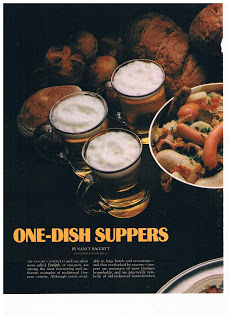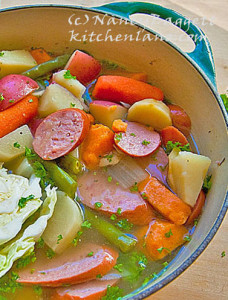How would I like to move there, he asked? My knee-jerk reaction: Oh no, I’m just starting to build my food writing reputation; it’s not a good time to move away. My second thought: Too bad it’s Germany—France would be fab!
Both of these those thoughts were sooo wrong-headed! First, our years in central Europe were personally enriching—we visited many interesting, unforgettable places, got to know some wonderful people, broadened our cultural horizons, and improved our foreign language skills.
I’m sure you’re guessing that the Bockwurst stew recipe below fits in with this post. It does. Not long after we’d settled into our house on the Main River outside Frankfurt, I was drooling over a Bon Appetit story on some homey French regional stews, fleetingly wishing once more that I lived on the Seine instead of the Main (pronounced “mine”). Then it hit me: The story’s well-known author was apparently already Bon Appetit’s go-to source on Mediterranean cooking. The editors would not likely want a feature on French food from lesser-credentialed me.
But nobody seemed to be “covering” central or eastern European cooking for Bon Appetit or its ilk. I immediately decided to learn everything I could about the food and wine in my area and hopefully turn myself into a resource American food editors actually might need. Eventually I pitched Bon Appetit a story on hearty, rustic Eintopfe, or “one-pots” that German home cooks liked to serve for simple family meals. The recipe here is good example. The editors not only bought the piece and ran it with nice visuals and play (as you can see below left), but assigned me a follow-up story on cooking with winter root vegetables and cabbage and various other “Kohls,” which were the produce staples of the central Europe.That piece ran as a cover story!
The food writing lessons here are so obvious they hardly need noting. First, try to embrace change and go with even the unsettling or scary flow. It will afford astonishing, unexpected opportunities to grow and learn—and the more you know, the more you can write about. At some point it dawned on me that everything I ever come upon—people, places, food and wine, agriculture, geography, cultural traditions, social history—is vital grist for my writing mill. The habit of being relentlessly inquisitive and acquisitive of information keeps you engaged, excited, and constantly primed with more fresh, new, interesting material than you’ll ever have time to cover.
Bockwurst Stew
When I lived in Germany I made this homespun 30-minute stew with Bockwurst sausages. They were as widely available and popular there as hotdogs are in the U.S. Now, I tend to ready it with the more easily obtained kielbasa; you could certainly use plump, top-quality wieners instead. I also like to throw in some chunks of sweet potato, though this vegetable was definitely not a staple called for in German cookery.
4 cups reduced-sodium chicken broth, plus more if needed
1 teaspoon each dried thyme leaves and caraway seed
1/4 teaspoon coarsely ground black pepper, or to taste
6 to 8 cups mixed fresh vegetable chunks (1- to 1 1/4-inch pieces), such as boiling potatoes, onions, carrots, parsnips, turnips, green beans
12- to 16-ounces bockwurst, kielbasa or similar link sausage, cut on a diagonal into 1/4 inch slices
4 or 5 green cabbage wedges
2 to 3 tablespoons chopped fresh parsley (coarse stems removed), optional
Makes 1 1/2 to 2 quarts, 4 or 5 generous main-dish servings. For some food writing lessons that I did have to learn the HARD way, go here.




Comments